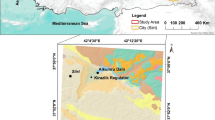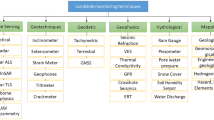Abstract
A large debris flow triggered by a rock avalanche in the Raunthi glaciated valley resulted in flash floods in the Rishiganga and Dhauliganga rivers on 07 February 2021 in Uttarakhand, India. Hydel projects, houses, roads and bridges in the path of debris flow were damaged resulting in many deaths. We have used high-resolution satellite data (e.g. Pleiades, WorldView, Kompsat, Cartosat, Resourcesat, Planet) to study the source of flash floods and cause of the slope failure. Our detailed geological assessment, carried out using stereoscopic Pleiades images (50 cm), revealed rock avalanche as the main source of slope failure. The slope failure has exposed a ~197-m-high head scarp near the crown and is controlled by two sets of joints and a foliation that helped in the wedge type failure. The volume of failed mass (rock and ice) estimated by cut and fill method using digital elevation models (DEMs) is ~ 29.3 million m3. The rock and ice descended from a height of ~5474 m and then crashed onto the moraine and ice bridges present in the valley at ~3732 m after travelling ~2.9 km along a steep slope. The heat generated by friction during run out and conversion of potential energy to kinetic energy due to the crashing on valley floor melted snow and ice. The ice melt water along with enhanced snow melting due to high ambient temperature on that day got intermixed with debris and created a slush, which was mobilised as a channelised flash flood. Multi-temporal high-resolution satellite data analysis showed that the debris flow was initiated at ~10:08:45 h (IST), and it travelled with a velocity of ~10.6 m/s. The rock avalanche event lasted for ~50 min, and the crash impact created a severe air blast in the valley. The rock avalanche has also resulted in debris blocking the Raunthi gad valley. Estimated Morphological Obstruction Index (MOI) and Hydro-morphological Dam Stability Index (HDSI) indicate the debris dam to be in an unstable domain.











Similar content being viewed by others
References
Bhukosh 2021 www.bhukosh.gsi.gov.in
Buss E, Heim A (1881) Der Bergsturz von Elm den 11. September 1881: Zurich, Wurster, 163 p
Collins GS (2014) Rock avalanche. In: Encyclopedia of planetary landforms. Springer, New York. https://doi.org/10.1007/978-1-4614-9213-9_321-1
Costa JE, Schuster RL (1988) The formation and failure of natural dams. Geol Soc Am Bull 100(7):1054–1068
Dai FC, Lee CF, Deng JH, Tham LG (2005) The 1786 earthquake-triggered landslide dam and subsequent dam-break flood on the Dadu River, southwestern China. Geomorphology 65(3):205–221
Delaney KB, Evans SG (2015) The 2000 Yigong landslide (Tibetan Plateau), rockslide-dammed lake and outburst flood: review, remote sensing analysis, and process modelling. Geomorphology 246:377–393
Dong J-J, Li Y-S, Kuo C-Y, Sung R-T, Li M-H, Lee C-T, Chen C-C, Lee W-R (2011) The formation and breach of a short-lived landslide dam at Hsiaolin village, Taiwan—part I: Post-event reconstruction of dam geometry. Eng Geol 123:40–59
Dunning SA, Mitchell WA, Rosser NJ, Petley DN (2007) The Hattian Bala rock avalanche and associated landslides triggered by the Kashmir Earthquake of 8 October 2005. Eng Geol 93(3-4):130–144
Goodman RE, Bray JW (1976) Toppling of rock slopes. Proceedings, Speciality Conference on Rock Engineering for Foundations and Slopes. American Society of Civil Engineers (ASCE), Boulder
Grodecki J, Dial G (2003) Block adjustment of high-resolution satellite images described by rational polynomials. Photogramm Eng Remote Sens 69:59–68
GSI (2021) A Preliminary report on recent flash flood disaster in Rishiganga-Dhauliganga valley, Chamoli district, Uttarakhand, pp 21
Gupta V, Sah MP (2008) Impact of the trans-Himalayan landslide lake outburst flood (LLOF) in the Satluj catchment, Himachal Pradesh, India. Nat Hazards 45(3):379–390
Hoek E, Bray JW (1981) Rock slope engineering. The Institution of Mining and Metallurgy, London, p 358
Huang D, Li YQ, Song YX, Xu Q, Pei XJ (2019) Insights into the catastrophic Xinmo rock avalanche in Maoxian county, China: combined effects of historical earthquakes and landslide amplification. Eng Geol 258:105158
Hungr O, Evans SG (2004) Entrainment of debris in rock avalanches: an analysis of a long run-out mechanism. Geol Soc Am Bull 116(9-10):1240–1252
ISRO (2021) Brief note on Uttarakhand flash floods—efforts of ISRO. pp 07
Kargel JS, Leonard GJ, Shugar DH, Haritashya UK, Bevington A, Fielding EJ, Young N (2016) Geomorphic and geologic controls of geohazards induced by Nepal’s 2015 Gorkha earthquake. Science 351(6269):aac8353
Kumar V, Gupta V, Jamir I, Chattoraj SL (2019) Evaluation of potential landslide damming: case study of Urni landslide, Kinnaur, Satluj valley, India. Geosci Front 10(2):753–767
Kumar V, Jamir I, Gupta V, Bhasin RK (2021a) Inferring potential landslide damming using slope stability, geomorphic constraints and run-out analysis; case study from the NW Himalaya. Earth Surface Dynamics 9:351–377. https://doi.org/10.5194/esurf-9-351-2021
Kumar V, Shukla T, Mehta M, Dobhal DP, Bisht MPS, Nautiyal S (2021b) Glacier changes and associated climate drivers for the last three decades, Nanda Devi region, Central Himalaya, India. Quat Int 575–576:213–226
Lagmay AMFA, Escape C, Ybañez AA, Suarez JK, Cuaresma G (2020) Anatomy of the Naga City landslide and comparison with historical debris avalanches and analog models. Front Earth Sci 8:312
Li T, Schuster RL, Wu J (1986) Landslide dams in south-central China. In: Proc. Landslide dams: processes, risk, and mitigation. ASCE Convention, Washington, pp 146–162
Martha TR, Vinod Kumar K (2013) September, 2012 landslide events in Okhimath, India—an assessment of landslide consequences using very high resolution satellite data. Landslides 10:469–479
Martha TR, Kerle N, Jetten V, van Westen CJ, Vinod Kumar K (2010) Landslide volumetric analysis using Cartosat-1-derived DEMS. IEEE Geosci Remote Sens Lett 7:582–586
Martha TR, Roy P, Babu Govindharaj K, Vinod Kumar K, Diwakar PG, Dadhwal VK (2015) Landslides triggered by the June 2013 extreme rainfall event in parts of Uttarakhand state, India. Landslides 12:135–146. https://doi.org/10.1007/s10346-014-0540-7
Maskey S, Kayastha RB, Kayastha R (2020) Glacial lakes outburst floods (GLOFs) modelling of Thulagi and Lower Barun glacial lakes of Nepalese Himalaya. Prog Disaster Sci 7:100106. https://doi.org/10.1016/j.pdisas.2020.100106
Penna IM, Hermanns RL, Nicolet P, Morken OA, Dehls J, Gupta V, Jaboyedoff M (2020) Air blasts caused by large slope collapses. GSA Bulletin 133(5-6):939–948. https://doi.org/10.1130/B35531.1
Shrestha AB, Eriksson M, Mool P, Ghimire P, Mishra B, Khanal NR (2010) Glacial lake outburst flood risk assessment of Sun Koshi basin, Nepal. Geomatics Nat Hazards Risk 1(2):157–169. https://doi.org/10.1080/19475701003668968
Stefanelli CT, Segoni S, Casagli N, Catani F (2016) Geomorphic indexing of landslide dams evolution. Eng Geol 208:1–10. https://doi.org/10.1016/j.enggeo.2016.04.024
Takahashi T, Nakagawa H (1993) Flood and debris flow hydrograph due to collapse of a natural dam by overtopping. Proc Hydraul Eng 12(2):41–49. https://doi.org/10.2208/prohe.37.699
Vinod Kumar K, Lakhera RC, Martha TR, Chatterjee RS, Bhattacharya A (2008) Analysis of the 2003 Varunawat landslide, Uttarkashi, India using earth observation data. Environ Geol 55:789–799
www.ndtv.com. Accessed on 8th February 2021
Žáček V, Bohdálek P, Břízová E, Buriánek D, Čáp P, Enkhjargal M, Čopjaková R (2017) Mongol Altai 50—a development cooperation project of Czech Republic with Mongolia in geology (2013–2016). Geosci Res Rep 50:159–166
Acknowledgements
We thank Dr. Raj Kumar, Director, NRSC, for his support and guidance to this work. IRS satellite data were provided by NDC, and we thank them for their quick response. We thank GSI for sharing their preliminary report with NRSC. We would like to thank the International Charter for Space and Major Disasters for providing high-resolution satellite data acquired before and after the event that enabled us to carry out the work for the disaster that has occurred in an inaccessible and remote location in the Himalaya.We would also like to thank Dr. Shantanu Bhatawdekar, Director, EDPO and Dr. G Srinivasa Rao, Associate Director, EDPO for their active support to this study. We are extremely thankful to NDMA, SDRF, USDMA, NTPC and IAF for their support during the fieldwork. We are thankful to the suggestions of anonymous reviewers which has improved the research paper.
Author information
Authors and Affiliations
Corresponding author
Rights and permissions
About this article
Cite this article
Martha, T.R., Roy, P., Jain, N. et al. Rock avalanche induced flash flood on 07 February 2021 in Uttarakhand, India—a photogeological reconstruction of the event. Landslides 18, 2881–2893 (2021). https://doi.org/10.1007/s10346-021-01691-9
Received:
Accepted:
Published:
Issue Date:
DOI: https://doi.org/10.1007/s10346-021-01691-9




